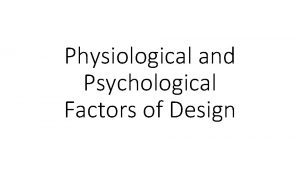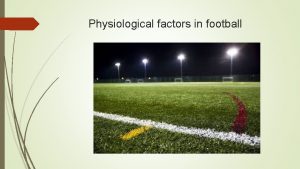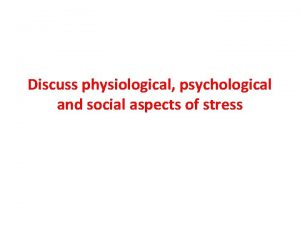Human Factors Physiological Aspects Psychological Aspects Human Interface











- Slides: 11

Human Factors • Physiological Aspects • Psychological Aspects • Human Interface with World of Work

Physiological Aspects of Human Performance • Physical structure of skeleton, muscles, nervous system, and metabolic processes • Bones-spine and upper and lower • Connected at body joints, wrist, knee etc • Joints connected by ligaments • Muscles contract and move bones • Expend energy to move • Biomechanics of motion

Psychological Aspects of Human Activities • What motivates people? • Do people like being idle? • Americans want “job enrichment”? • Who has the best ideas on how to increase productivity? • What makes people more positive at work?

Psychological Aspects of Human Activities • People are still motivated by money • People would rather be doing productive work than be idle • Many workers do not necessarily want “job enrichment” • Workers often have the best ideas on how to increase productivity if only asked • Most people respond ++ when they know objectives, what their jobs are, that they will be treated fairly, consistently and with respect

Human Interface with Work • Important interfaces – Work Environment – Social Structures – Machines – Information/Communication Systems – Organizational/Supervisory Structure – Robots/”Intelligent Machines”

Interface with Work Environment • IE’s design workplaces • Optimal location for devices • Illumination • Atmosphere • Safe and Attractive

Interface with Machines • Human serves a control function • Human factors data used to select size, shape and location of controls • Humans are better at: – Recognizing…. – Storing…. – Other words….

What are we better at? • Recognizing complex patterns • Recognizing unusual/unexpected events • Storing lots of info, long time, strategies • Quick retrieval, associating, inferring • Adapting the decision process • Reasoning inductively • Discerning most important activities

What are machines better at? • Monitoring prespecified events • Storing quantitative data quickly (lots) • Retrieving and processing data quickly • Performing repetitive activities • Responding to inputs consistently, fast • Ignoring distractions

Interface with Information/Communication Systems – One portion • Auditory vs. Visual Presentation • Auditory – Message short, simple – Not referred to later – Deals with events in time – Calls for immediate action – Visual system overburdened – Too bright, have to move a lot

More Interface: Auditory or Visual • Visual – Message is complex and long – Referred to later – Deals with location in space – Does not call for immediate action – Auditory system overburdened – Location is noisy, worker in one position
 Psychological aspects of interlanguage
Psychological aspects of interlanguage Module 3 psychological factors
Module 3 psychological factors Physiological factors
Physiological factors Psychological factors affecting sports performance
Psychological factors affecting sports performance Factors affecting oxygenation slideshare
Factors affecting oxygenation slideshare What physiological factors produce hunger?
What physiological factors produce hunger? Physiological factors affecting food selection
Physiological factors affecting food selection Module 2 physiological factors
Module 2 physiological factors Physiological factors
Physiological factors Dynamics of personality examples
Dynamics of personality examples Factors affecting learning in psychology
Factors affecting learning in psychology Psychological factors affecting sports performance
Psychological factors affecting sports performance




















